Cooking from the Polski Sklep
Marta Zboralska’s recipes for zupa owocowa (fruit soup) and naleśniki z serem (pancakes with sweet cheese filling). Photos by Georgia Rudd.
Good morning, and welcome to Vittles! Today, we’re publishing a bonus Cooking column, a sequel to the cultural history of the polski sklep by Kasia Tomasiewicz and Marta Zboralska published last year, Marta brings us two recipes you can make using ingredients from the polski sklep: zupa owocowa (fruit soup) and naleśniki z serem (pancakes with sweet cheese filling).
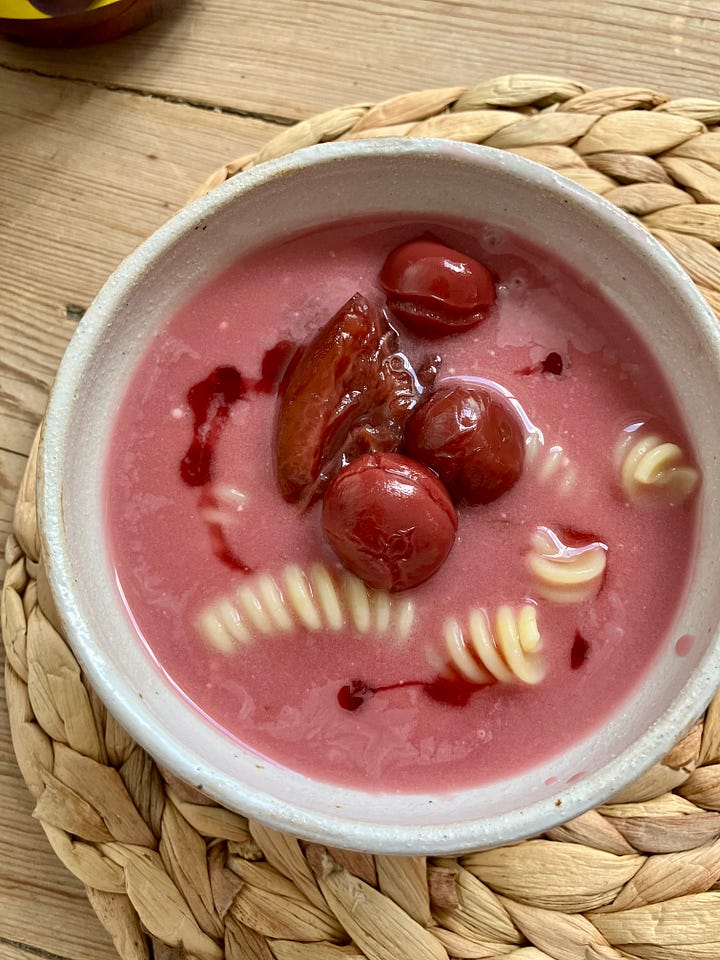
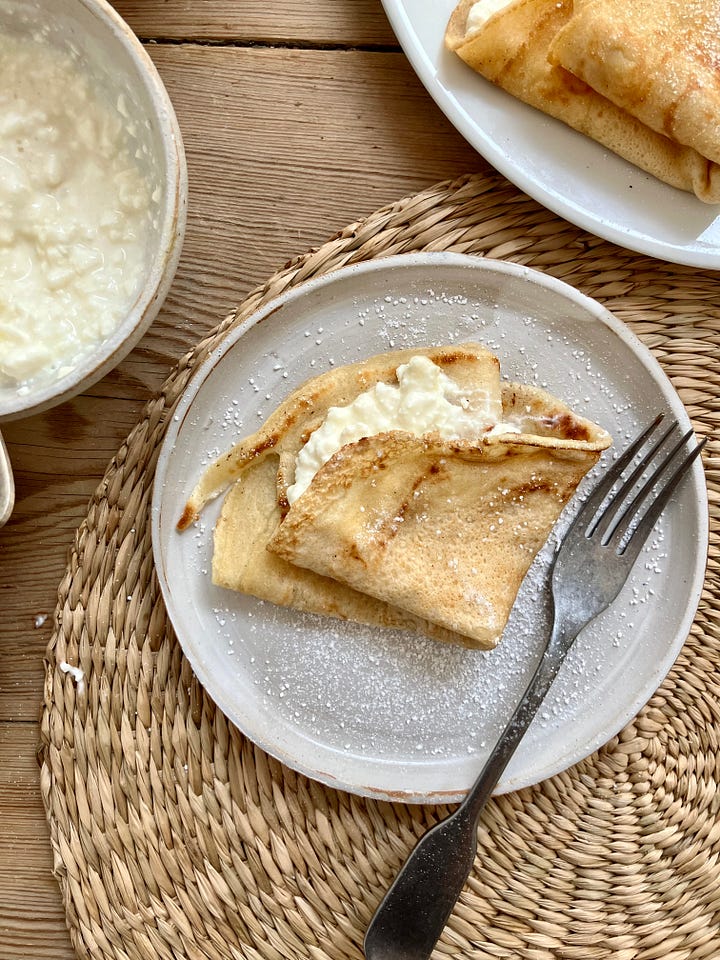
I know what you’re thinking, because many of my Polish friends feel similarly: fuj! (Yuck!) Fruit soup is a divisive dish, even in Poland, but one that I have long loved. It is generally associated with school – particularly nursery schools, alongside warm milk that always had a skin, Inka (a cereal alternative to coffee) and vanilla-flavoured semolina topped with raspberry syrup.
Between the ages of six and fifteen, my school lunch consisted of the same rotating set of dishes, served in the same canteen. Every day, there were two courses – a soup and a main – and in the summer months in particular, one of these might have been sweet. It was not unusual to have fruit soup as the first course and to follow it with pan-fried liver. Another seasonal pairing was tomato soup and cold, slightly overcooked rice with cream and blueberries. And while the set meal required a monthly subscription, the bottomless soup alone was always free for everyone, no questions asked.
Fruit soup’s relative infrequency on the menu made it exciting – a break in the delicious but endless stream of gherkin and potato – a pink anachronism for post-communist children growing up in the age of Fruit-tella excess. Made from a mixture of red summer fruits, such as strawberries, redcurrants and cherries, the dish is, in essence, a soup version of kompot: a juice made from stewed fruit that is Poland’s answer to squash. Often served over pasta, fruit soup is thickened with potato starch, generally in the form of kisiel: a delicious fruit gloop like barely set jelly, beloved of children and students alike, that is available in dozens of instant varieties (these days including a ‘Shrek’ version, a more slime-oriented alternative to the dominant hues of pink). For me, fruit soup works best when finished with a dollop of śmietana, or soured cream (NB: this is not the same as the sour cream you get in standard UK supermarkets – so make sure to head to the polski sklep to find it).
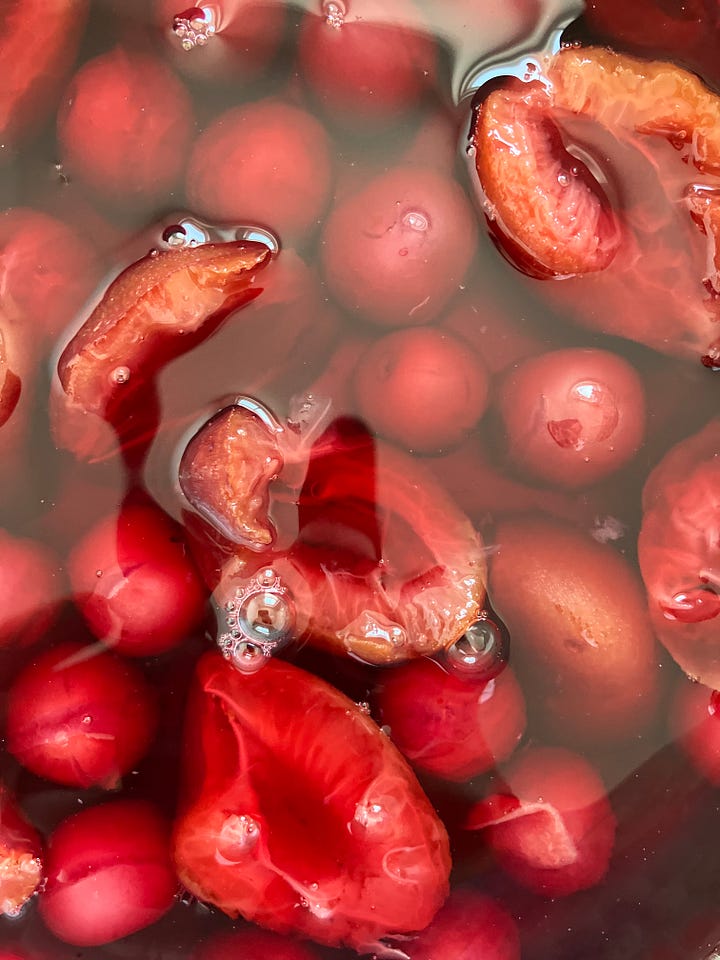
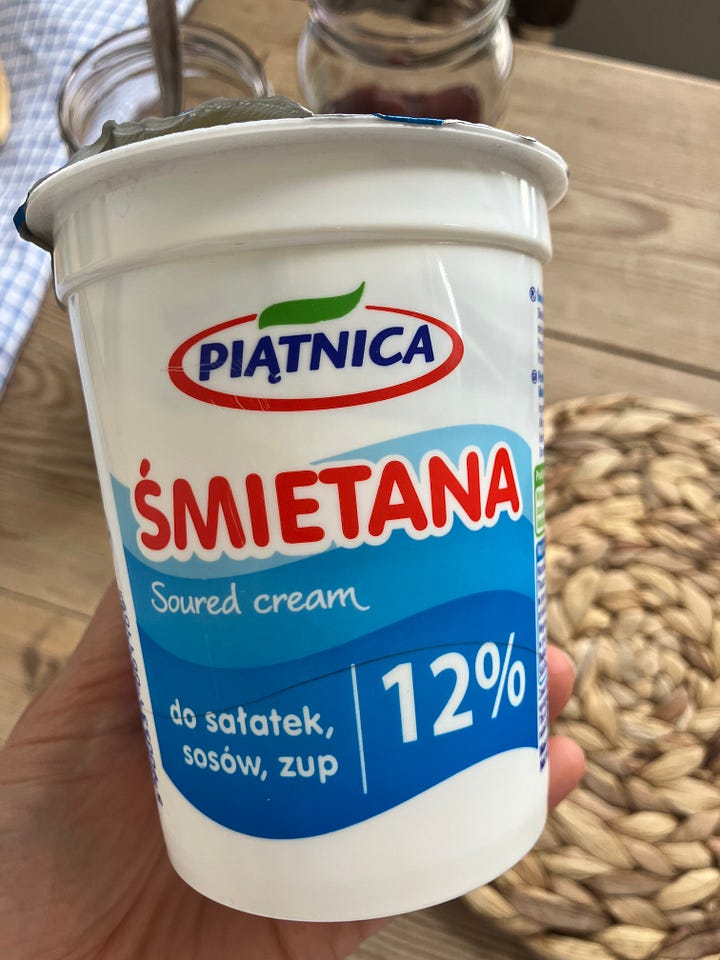
During my Polish school years, it never occurred to me that starting with sweet before moving to savoury, or making pastas with fruit, might be anything out of the ordinary – and still, to my mind, pasta works well with creamy soups and sauces of all temperaments. I think that much of the hatred of fruit soup has less to do with its flavour than with a childlike incongruity, a sweet–savoury ambivalence that feels at odds with adulthood, when people drink bitter coffee, not sweet Inka, and are known to enjoy olives.
More acceptable to grown-ups as an occasional treat is another Polish staple: naleśniki – pancakes, or, more precisely, crêpes, although they are not quite the same – filled with sweet curd cheese and rolled into loose scrolls or neatly tucked into triangles. Naleśniki are endlessly customisable: the curd filling can be applied sparingly or in excess, range in texture from grainy to silky smooth, and vary in flavour from the sour to cheesecake-sweet. The pancakes are eaten cold or hot, or even, once assembled, refried in the pan in some more butter to make the edges deliciously crispy, and can be served with a sprinkling of sugar, a dollop of śmietana (again sweetened to taste) or on their own. Though they might be less playful than fruit soup, they can have a sense of childish transgression if you serve them as a sweet main – a messing up of the order of things, a refusal of delayed gratification.
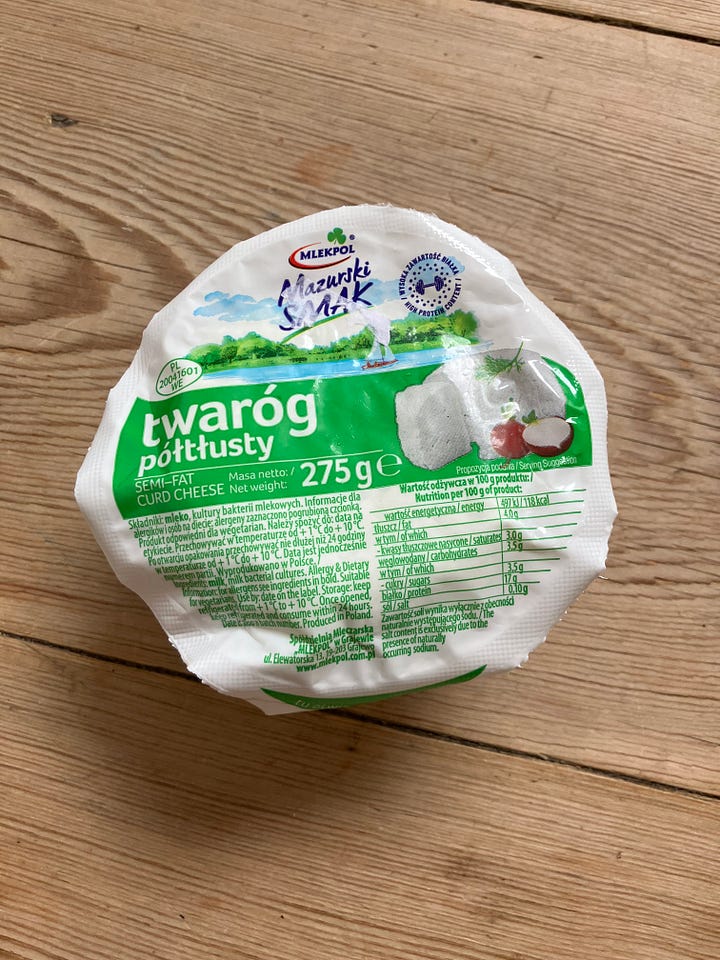
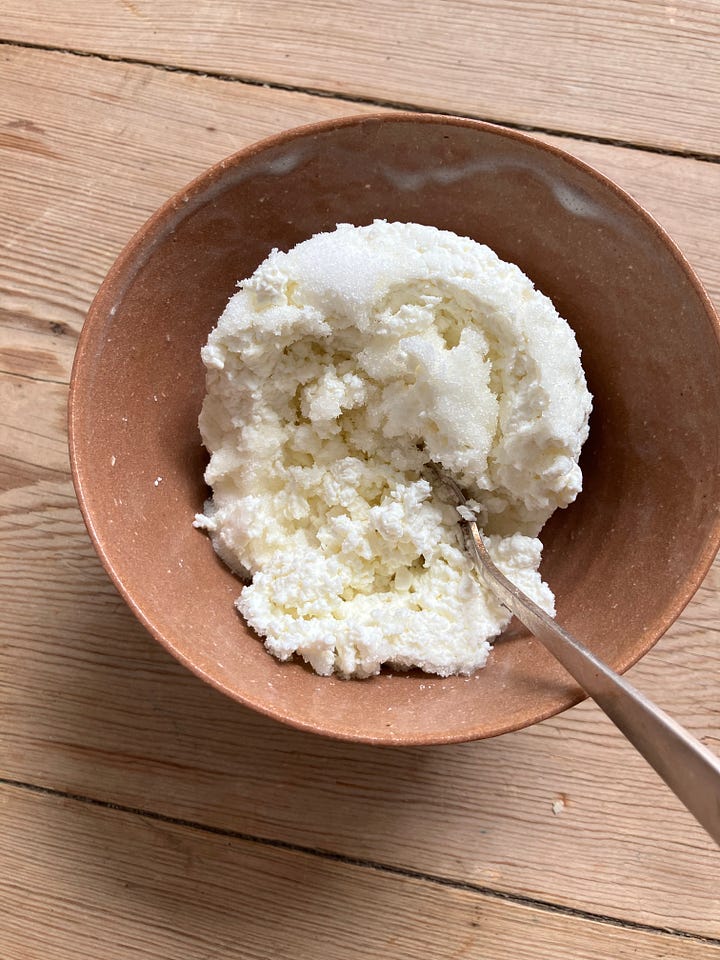
Making either of these dishes will necessitate a trip to your local polski sklep. While there, enjoy the fading spoils of the Polish warmer months: huge raspberry tomatoes, whole sunflower heads to pick seeds from, and ogórki małosolne (cucumbers in salt brine) – if you’re lucky enough to live near a sklep that has a tub.
Zupa Owocowa (Fruit Soup)
Serves 3
Time 25 mins
Ingredients
2 x 900g jars of summer fruit kompot (choose two different varieties; see notes)
250ml apple juice
1 x 30g Dr Oetker Słodka Chwila cherry or strawberry kisiel sachet (see notes)
80g śmietana (12% fat; I used the Piątnica brand – this is soured cream, not sour cream!)
150g fusilli
Method
Use a slotted spoon to transfer 200g of fruit from each of the kompot jars into a large saucepan. If you’ve chosen a flavour that contains stones, such as sour cherry, destone if you prefer (or if serving to children). Strain 250ml of juice from each jar into the saucepan with the fruits, and mix to combine.
Add the apple juice to the pan and put over a medium heat.
Meanwhile, in a separate jug, dissolve the kisiel in 50ml water and mix until thickened.
When the kompot mixture is hot, pour in the thickened kisiel. Cook, stirring, for a few more minutes until you feel the soup thicken slightly. Make sure to take the pan off the heat before it starts to boil. Set aside to cool.
Cook the fusilli according to packet instructions.
When the pasta is cooked, put the śmietana in a small bowl. Add 5 tbsp of the soup, which should by now be lukewarm, and stir until the mix is loosened and combined. Pour this mixture into the saucepan and stir into the soup.
Divide the pasta between three serving bowls and pour over soup. Serve lukewarm, or cold if you prefer. If you have not destoned the fruit, don’t forget to be careful.
Notes
I like the Edmal brand of kompot. In terms of flavour combinations, I particularly recommend sour cherry with strawberry – ie kompot wiśniowy and kompot truskawkowy. Note that sour cherry kompots are likely to have stones!
You will find kisiel in the jelly or custard powder section of the polski sklep. Ensure that you choose the smooth variety of kisiel (ie without freeze-dried fruit chunks) – look for ‘kisiel’ on the packet rather than ‘kisiel z kawałkami owoców’.
Keep the leftover kompot in the fridge. Dilute it with water to make a refreshing drink.
Naleśniki z serem (Pancakes with Sweet Cheese Filling)
Makes 5–6 (depending on the size of your frying pan)
Time 30 mins
Ingredients
25g unsalted butter
180g plain flour
a pinch of salt
200ml milk
100ml sparkling water
1 egg
icing sugar, to serve (optional)
for the filling
250g twaróg półtłusty (half-fat curd cheese; I used the brand Łowicz)
1 x 16g sachet cukier wanilinowy (vanilla sugar; see notes)
1 heaped tbsp caster sugar, plus extra to taste
200g 12% śmietana (soured cream) plus extra to serve (optional)
Method
Melt the butter in a large frying pan, then transfer to a small bowl and allow to cool slightly.
Mix the flour and salt in a large bowl. In a separate jug or bowl, whisk the milk, sparkling water and egg together.

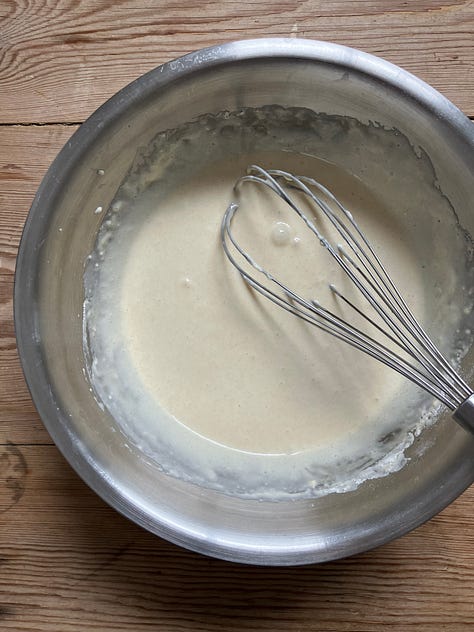

Make a well in the middle of the dry ingredients, then slowly pour in the wet mixture, whisking until smooth and evenly combined, with no air pockets left.
Mix the melted butter into the batter.
Wipe any excess butter off the frying pan, but leave a thin layer. Place the pan over a medium heat.
Once the entire pan is hot, pour a ladle of batter into the middle and swirl evenly around the pan. You want the crêpes to be thin – but not paper-thin. Fry on both sides, using a thin fish slice to turn, for 30–45 seconds, until cooked and golden. Set the pancakes aside on a plate lined with baking parchment while you make the filling.
Mix all the filling ingredients in a bowl until you achieve your desired texture. It might be useful to use a fork to mash the curd cheese. Taste the filling and add more sugar if necessary.
Spread the filling evenly over each crêpe, or experiment with different filling-to-crêpe ratios, then roll into a scroll or fold into a triangle. If you want, fry the folded pancakes in a bit more butter until crispy (triangles lend themselves better to this).
Serve hot or cold, with a dollop of śmietana sweetened to taste, or a sprinkling of icing sugar, or just on their own.
Notes
You will find cukier wanilinowy in the baking section of the polski sklep.
Marta Zboralska is an art historian working on a book about art and Witold Gombrowicz.
These recipes were photographed and tested by Georgia Rudd.
The Vittles masthead can be viewed here.




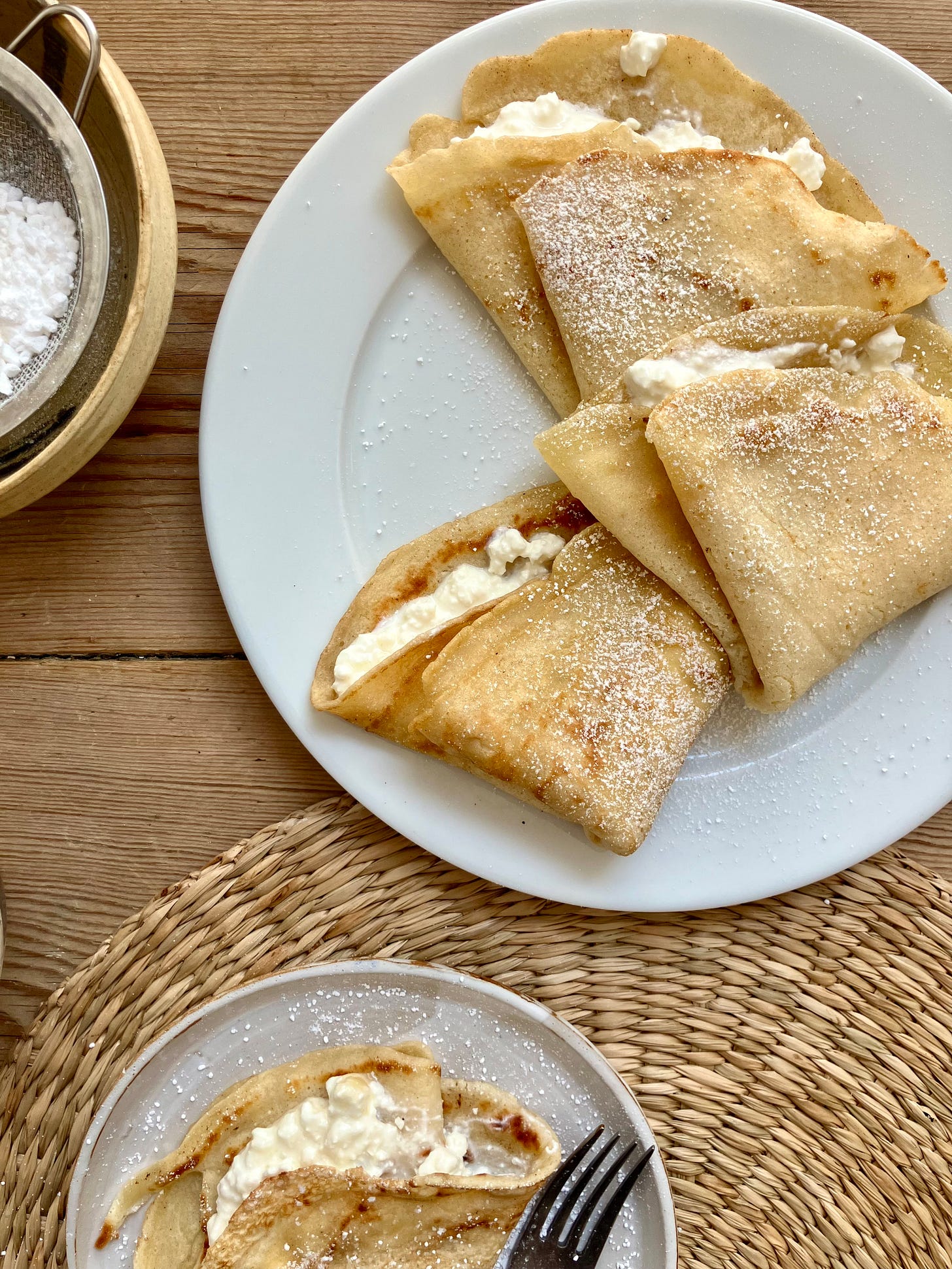
🫶🫶🥳🇵🇱